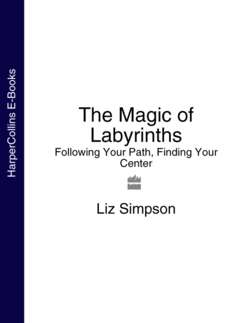Читать книгу The Magic of Labyrinths: Following Your Path, Finding Your Center - Liz Simpson - Страница 16
Labyrinths in Popular Culture
ОглавлениеIn fairy stories, while labyrinths or mazes are seldom implicitly mentioned, the notion of the Prince hacking his way through a dense, complex forest in order to reach the Sleeping Beauty, is just one metaphor for the trials and tests one must engage in to reach a prized goal. Indeed, many such stories involve the protagonists enduring a series of tasks – for which they appear initially unprepared – that suggest a journey to find their female side (the “princess”) in order to become complete human beings.
The Jungfruringen or Virgin’s Ring, Sweden, with its two entrances. Young men would race each other to reach the maiden in the center first.
Given the richness and complexity of the labyrinth as a metaphor for life, this motif has captured the imagination of writers, most of who allude to intricacies or entanglements of one sort of another. In Troilus and Cressida, Shakespeare writes: “How now Thersites? What, lost in the Labyrinth of thy furie?” The poet Shelley opined: “From slavery and religion’s labyrinth caves, Guide us.” And from W.B. Yeats: “Does the imagination dwell the most, Upon a woman won or woman lost? If on the lost, admit you turned aside, From a great labyrinth out of pride.”
In the world of popular fiction, labyrinths – explicit or allegorical – appear in the likes of Mervyn Peak’s Gormenghast novel Titus Groan, in the description of the Stone Lanes region; as the Mines of Moria in J.R.R. Tolkien’s The Lord of the Rings and in Terry Pratchett’s Small Gods with the “booby-trapped labyrinth of Ephebe.” J.K. Rowling has even incorporated a maze in the Tri-Wizard Tournament, that her hero must navigate at the end of Harry Potter and the Goblet of Fire.
But my favorite example of a labyrinth in a book is in Neil Gaiman’s Neverwhere, described as a dark, contemporary Alice in Wonderland. In the story, an ordinary man named Richard Mayhew becomes trapped in London Below and must negotiate the labyrinth and its beast in order to reach and vanquish the ultimate enemy – an angel who has “gone bad.” Mayhew alone succeeds where others (traditionally more powerful) in his party fail, despite losing the talisman that he had been told would ensure his safe passage through the labyrinth. After successfully killing the beast, our hero is told to apply its blood to his eyes and tongue so that he can negotiate the passages with ease.
The wonderful message of this part of the book is that facing and disposing of the “monster within” – a concept Jung referred to as our “shadow” – is a precursor to converting the journey from a puzzling maze into a labyrinth. By doing this, your way becomes “straight and true” during which you know “…instinctively every twist, every path, every alley…” Thus, Gaiman reminds us, tackling the inner Beast – whether that be our fears, our self-neglect, our cowardice or denial of reality – allows us to navigate life’s journey by tapping into our inner compass or intuition. In this way we discover that life’s path involves an easier and more straightforward approach than we originally thought. (For more on how we can change our own lives from resembling mazes to becoming more like labyrinths, see here.)
Also worth mentioning in this context is the movie Labyrinth, Jim Henson’s dark, allegorical tale of a teenager who wishes her annoying baby brother would be taken away by goblins – and he is; a classic case of “beware of what you wish for.” Our heroine, Sarah, is then given thirteen hours to rescue the boy, before he is turned into a goblin. She accomplishes her quest, which superficially involves solving riddles and a race against time, but in essence it concerns the process of growing up and discovering what is really important in life.
